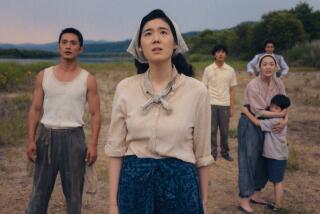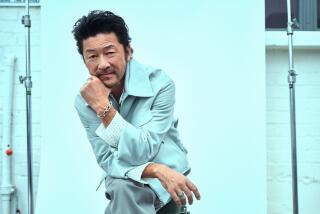‘Asako I & II’ is a playful, haunting drama of love lost and regained
- Share via
A cataclysm strikes almost halfway through “Asako I & II,” killing the lights, rattling the walls and briefly tearing the fabric of this quietly entrancing Japanese drama. But the writer-director, Ryûsuke Hamaguchi, has little interest in staging a mass tragedy for its own sake. Instead, he cuts to the more intimate spectacle of a man and a woman embracing in the wake of disaster — a mutual declaration of love that, given what we know about them by that point, feels at once sweet, beguiling, inevitable and alarming.
The scene in question pointedly mirrors the movie’s opening sequence at an Osaka art gallery, where the woman — the lovely, demure Asako (Erika Karata) — and a handsome, tousle-haired stranger named Baku (Masahiro Higashide) first lock gazes. Time seems to slow even as the pulse quickens, and Baku impulsively approaches Asako and takes her in his arms. It’s a gloriously heightened and blatantly artificial movie-movie moment, complete with a catchy synth riff (courtesy of composer Tofubeats) and a round of exploding firecrackers. Before these two even know each other, their love has become the stuff of destiny, cinematically immortalized.
Hamaguchi, best known for his absorbing five-hour-plus relationship epic “Happy Hour,” is especially good at those moments. The surfaces of his pictures can be so sedate, refined and gently inviting that you’re seldom prepared when their emotional crosscurrents suddenly dovetail, knocking you back on your heels. “Asako I & II,” which is screening four times this weekend at Ahrya Fine Arts (courtesy of Acropolis Cinema and Film at LACMA), is a peculiarly potent story about life’s unexpected little ruptures — those odd coincidences, repetitions and shifts in perspective that can set off aftershocks in the human heart.
Asako falls hard for Baku, ignoring the warnings of her close friend Haruyo (Sairi Itô) that he will break her heart. And so he does. The driftiest of bad boys, Baku exits the scene one day without explanation, leaving the devastated Asako to pick up the pieces of her life and move on. Two years later, she’s working at a coffee shop in Tokyo, never dreaming that she will come face to face with Baku again — or rather, with Ryôhei, a dead ringer for her ex-boyfriend. (He is also played by Higashide.)
Ryôhei works in advertising for a liquor company, and he is as dependable and down-to-earth as Baku was broody and erratic. Asako once clung desperately to Baku, but she is now ardently pursued by Ryôhei, who senses their shared attraction but has no idea why she seems so shy and frightened in his presence. Eventually, that earthquake hits and brings Ryôhei and Asako together, initiating another leap forward in time and, soon, another jaw-dropping surprise. Suffice to say that the specter of “Vertigo,” Alfred Hitchcock’s inexhaustible masterwork of romantic obsession, hangs heavily over this tale of a lost lover who is unexpectedly found.
Adapting a novel by Tomoka Shibasaki, Hamaguchi and his cowriter, Sachiko Tanaka, display a clear fascination with doubles and doppelgängers of every kind. The two acts of “Asako I & II” mirror each other in subtly playful ways, with formal and structural echoes throughout. Nearly every event in the first half recurs, more sadly, in the second, as if to acknowledge that life’s consequences grow only crueler and more permanent with age. An early mistake can be easily forgiven and forgotten. Another one years later has much graver consequences.
There may be two men in this movie with the same face, but as the title suggests, there are also two Asakos — one determined to move forward in life and love, the other unwilling to give up a dream from the past. More than once, Hamaguchi shoots Asako from the back, as if to confound your sense of which version of the character you’re going to get. All this vertiginous doubling might have left “Asako I & II” feeling like a purely technical exercise, though Hamaguchi’s form and technique are always in service of his characters and the worlds they inhabit.
The regular establishing shots of gray skies and peaceful cityscapes lull us into a deceptive state of calm that, miraculously, doesn’t clash with the movie’s rapidly self-multiplying complications. The more openly absurd the story gets, the plainer, deeper and more lucid its emotions become. The central dilemma in “Asako I & II” goes beyond the idea of choosing between two lovers; it’s about choosing which world to believe in — the real one with its rules and compromises or the impossibly romantic one that movies and other works of the imagination love to extol.
Is this itself a false dichotomy? Maybe, maybe not. Certainly, the question looms over the picture’s most exquisite sequence, in which Asako’s friend Maya (Rio Yamashita), an up-and-coming stage actress, is set up on a date with Kushihashi (Kôji Seto). There’s another clever doubling there if you’re looking for it, and also one more blatant coincidence I won’t spoil. But the glory of the scene lies in the sensitivity of the writing and the direction, the way Hamaguchi allows a difficult, awkward and ultimately vital human interaction to play out at uninterrupted length. He does that again and again in “Asako I & II,” taking a story that might have settled for gimmickry and finding an achingly human pulse.
‘Asako I & II’
In Japanese with English subtitles
Not rated
Running time: 1 hour, 59 minutes
Playing: Aug. 23-25, Ahrya Fine Arts by Laemmle, Beverly Hills
More to Read
Only good movies
Get the Indie Focus newsletter, Mark Olsen's weekly guide to the world of cinema.
You may occasionally receive promotional content from the Los Angeles Times.









